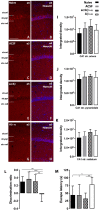Amyloid-Beta1-42 -Induced Increase in GABAergic Tonic Conductance in Mouse Hippocampal CA1 Pyramidal Cells
- PMID: 32041202
- PMCID: PMC7037727
- DOI: 10.3390/molecules25030693
Amyloid-Beta1-42 -Induced Increase in GABAergic Tonic Conductance in Mouse Hippocampal CA1 Pyramidal Cells
Abstract
Alzheimer's disease (AD) is a complex and chronic neurodegenerative disorder that involves a progressive and severe decline in cognition and memory. During the last few decades a considerable amount of research has been done in order to better understand tau-pathology, inflammatory activity and neuronal synapse loss in AD, all of them contributing to cognitive decline. Early hippocampal network dysfunction is one of the main factors associated with cognitive decline in AD. Much has been published about amyloid-beta1-42 (Aβ1-42)-mediated excitotoxicity in AD. However, increasing evidence demonstrates that the remodeling of the inhibitory gamma-aminobutyric acid (GABAergic) system contributes to the excitatory/inhibitory (E/I) disruption in the AD hippocampus, but the underlying mechanisms are not well understood. In the present study, we show that hippocampal injection of Aβ1-42 is sufficient to induce cognitive deficits 7 days post-injection. We demonstrate using in vitro whole-cell patch-clamping an increased inhibitory GABAergic tonic conductance mediated by extrasynaptic type A GABA receptors (GABAARs), recorded in the CA1 region of the mouse hippocampus following Aβ1-42 micro injection. Such alterations in GABA neurotransmission and/or inhibitory GABAARs could have a significant impact on both hippocampal structure and function, causing E/I balance disruption and potentially contributing to cognitive deficits in AD.
Keywords: GABA 1; GABAA receptor 2; amyloid-beta 4; hippocampus 5; tonic inhibition 3.
Conflict of interest statement
The authors declare no conflict of interest.
Figures


Similar articles
-
Early alterations in hippocampal perisomatic GABAergic synapses and network oscillations in a mouse model of Alzheimer's disease amyloidosis.PLoS One. 2019 Jan 15;14(1):e0209228. doi: 10.1371/journal.pone.0209228. eCollection 2019. PLoS One. 2019. PMID: 30645585 Free PMC article.
-
Input-Specific Synaptic Location and Function of the α5 GABAA Receptor Subunit in the Mouse CA1 Hippocampal Neurons.J Neurosci. 2019 Jan 30;39(5):788-801. doi: 10.1523/JNEUROSCI.0567-18.2018. Epub 2018 Dec 6. J Neurosci. 2019. PMID: 30523065 Free PMC article.
-
Enhancement of tonic and phasic GABAergic currents following nitric oxide synthase inhibition in hippocampal CA1 pyramidal neurons.Neurosci Lett. 2015 Mar 17;590:29-34. doi: 10.1016/j.neulet.2015.01.058. Epub 2015 Jan 27. Neurosci Lett. 2015. PMID: 25636692
-
Epileptic Mechanisms Shared by Alzheimer's Disease: Viewed via the Unique Lens of Genetic Epilepsy.Int J Mol Sci. 2021 Jul 1;22(13):7133. doi: 10.3390/ijms22137133. Int J Mol Sci. 2021. PMID: 34281185 Free PMC article. Review.
-
Significance of GABAA Receptor for Cognitive Function and Hippocampal Pathology.Int J Mol Sci. 2021 Nov 18;22(22):12456. doi: 10.3390/ijms222212456. Int J Mol Sci. 2021. PMID: 34830337 Free PMC article. Review.
Cited by
-
Loss of Extrasynaptic Inhibitory Glycine Receptors in the Hippocampus of an AD Mouse Model Is Restored by Treatment with Artesunate.Int J Mol Sci. 2023 Feb 27;24(5):4623. doi: 10.3390/ijms24054623. Int J Mol Sci. 2023. PMID: 36902054 Free PMC article.
-
Therapeutic potential of alpha 5 subunit containing GABAA receptors in Alzheimer's disease.Neural Regen Res. 2021 Aug;16(8):1550-1551. doi: 10.4103/1673-5374.300987. Neural Regen Res. 2021. PMID: 33433477 Free PMC article. No abstract available.
-
Targeting the Cation-Chloride Co-Transporter NKCC1 to Re-Establish GABAergic Inhibition and an Appropriate Excitatory/Inhibitory Balance in Selective Neuronal Circuits: A Novel Approach for the Treatment of Alzheimer's Disease.Brain Sci. 2022 Jun 15;12(6):783. doi: 10.3390/brainsci12060783. Brain Sci. 2022. PMID: 35741668 Free PMC article. Review.
-
The interaction between neurotransmitter receptor activity and amyloid-β pathology in Alzheimer's disease.J Alzheimers Dis. 2025 Jul;106(2):391-409. doi: 10.1177/13872877251342273. Epub 2025 Jul 1. J Alzheimers Dis. 2025. PMID: 40388923 Review.
-
An Expanded Narrative Review of Neurotransmitters on Alzheimer's Disease: The Role of Therapeutic Interventions on Neurotransmission.Mol Neurobiol. 2025 Feb;62(2):1631-1674. doi: 10.1007/s12035-024-04333-y. Epub 2024 Jul 16. Mol Neurobiol. 2025. PMID: 39012443 Free PMC article. Review.
References
-
- Ren S.-Q., Yao W., Yan J.-Z., Jin C., Yin J.-J., Yuan J., Yu S., Cheng Z. Amyloid β causes excitation/inhibition imbalance through dopamine receptor 1-dependent disruption of fast-spiking GABAergic input in anterior cingulate cortex. Sci. Rep. 2018;8:302. doi: 10.1038/s41598-017-18729-5. - DOI - PMC - PubMed
MeSH terms
Substances
Grants and funding
LinkOut - more resources
Full Text Sources
Other Literature Sources
Miscellaneous

